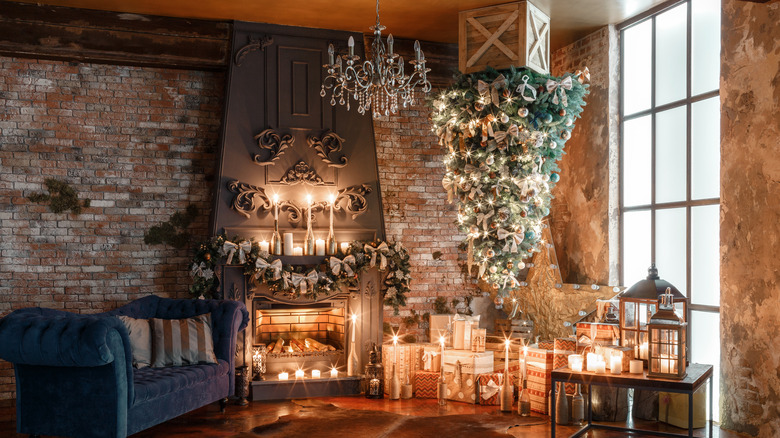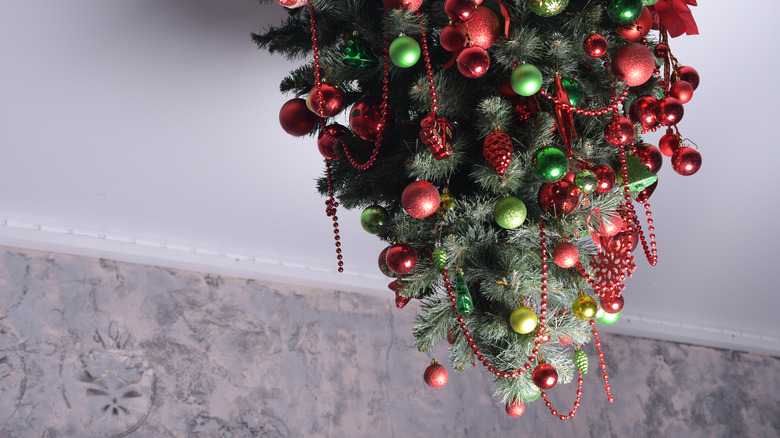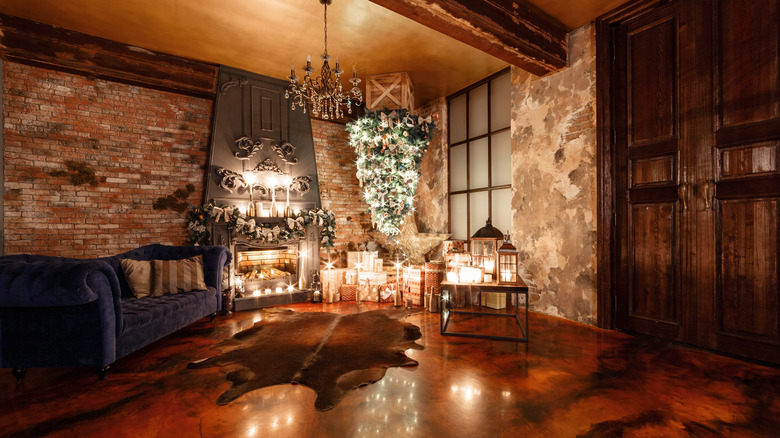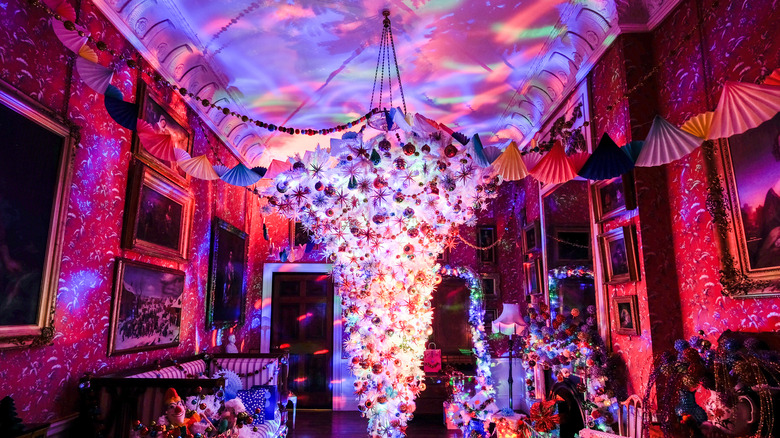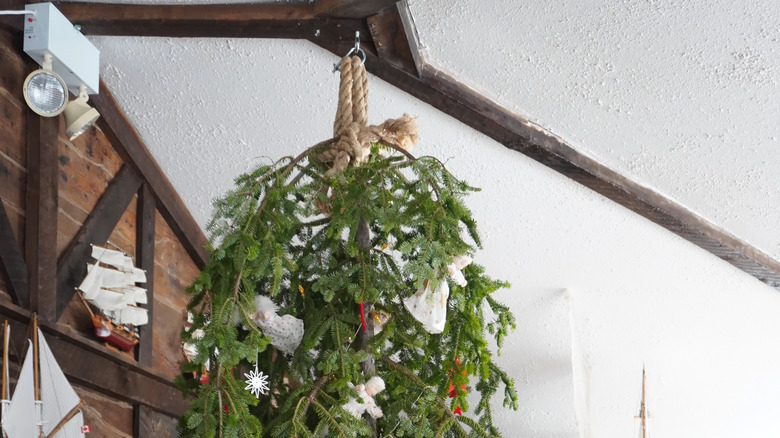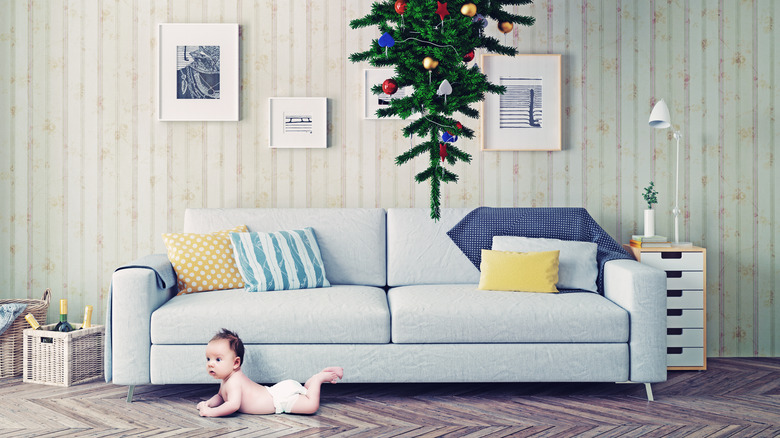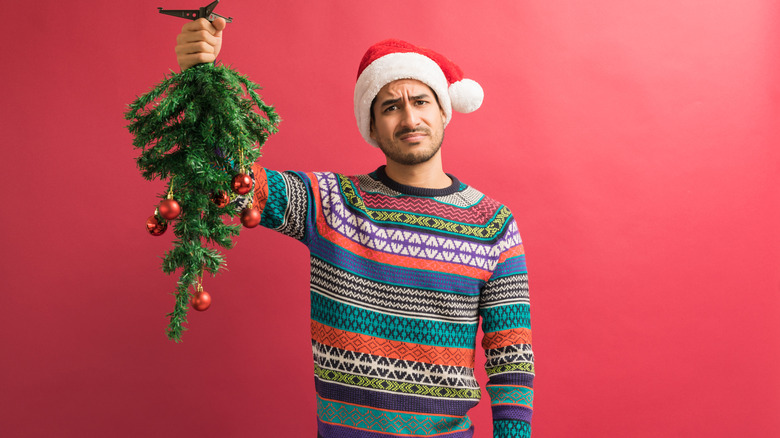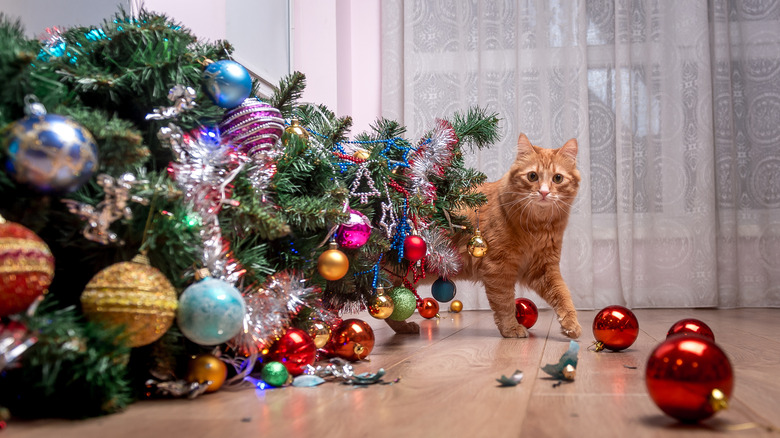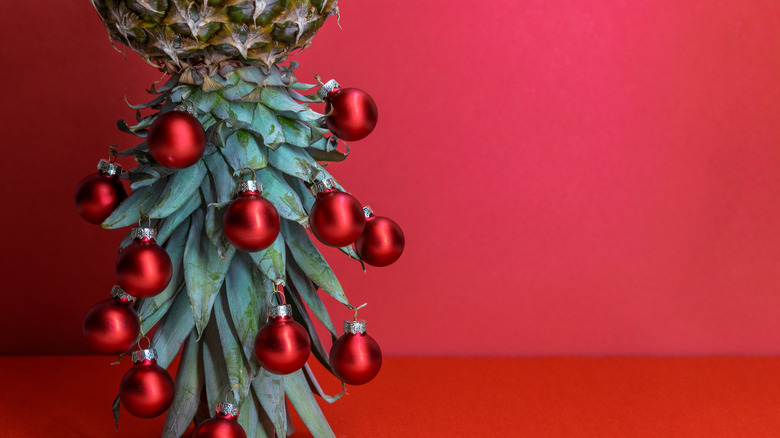What Is An Upside Down Christmas Tree And How Are People Doing This?
Common for centuries and loved by many today, the inverted, or upside down Christmas tree is a fabulous alternative in holiday decorating. While the history of this practice spans many cultures, historians often focus on the podłazniczek, which was a popular practice with roots in Polish folklore. Translated from Lasy.gov, the practice included hanging an inverted spruce, or sometimes a branch or burlap sack depending on a household's means. The tree was then decorated with highly significant colors including white (representing the innocence of babies), deep green (life lasting forever), red (wellness), and gold (abundance).
Original decorations also included fruit, nuts, "Heavenly apples", feathers, twigs, tissue paper — basically anything pretty and available that fit the theme. Candles were lit on branches and presents from Grandfather Frost were piled below, alluding to the Santa traditions we celebrate today. These traditions have melded with many of the religiously significant histories of the upside down Christmas tree to create our emerging design choice for today.
History behind the upside down Christmas tree
Beyond the Polish tradition, the right-side up Christmas tree has definite pagan origins around the fourth century. However, according to Newsweek, the inverted version seems to have more Christian origins. Country Living describes tales of this trend dating back to seventh century Benedictine monk Boniface who used the shape to explain the Holy Trinity to pagan Germans. There is also a correlation between the upside down silhouette and Christianity with the top-heavy display reminiscent of the crucifixion of Jesus (visualize a cross with wide top and narrow pole) dating to 12th Century Eastern Europe.
Perhaps more popular in the modern day, the habit of hanging a tree upside down became popularized again in the 19th century for one simple reason: saving space. Bernd Brunner, author of "Inventing the Christmas Tree" explains, "In the small common rooms of the lower classes, there was simply no space" (via CBC). This efficient use of display area is a trend that continues today, a quaint solution for the high prices of real estate and rising popularity of tiny homes.
How does an upside down Christmas tree work?
An upside down Christmas tree is typically hung from the ceiling, although some people also hang smaller trees from a wall or door. The trunk part goes up and the tree part goes down, but what next? How do you decorate these trees and what do you do with presents? Rather than watching your Christmas Star topple off the pointy end, Better Homes & Gardens has a few tips to help you figure out how things work.
Much like a traditional tree you can start by wrapping with your favorite twinkle lights or garlands. Either direction up, these should stick. The same applies to hanging your favorite ornaments. The hooks work the same but you will likely have better overall visibility due to the open space beneath as the items hang towards smaller branches. The biggest difference is your tree topper. Clearly, this will need to be attached well instead of simply set above, but you can actually use a larger topper knowing you'll have additional display space and that this "headliner" will be closer to eye-level.
As for presents, you'll have even more space. Not limited to simply the room below a tree, you can arrange stacks to be loosely scattered at the base or stacked in piles near the fireplace.
How to display an upside down Christmas tree
How to display an upside down Christmas tree may take a little more thought than a traditional option. You'll first need to consider safety — don't hang a tree where your head will smash into the display. You'll also want to avoid hanging items near doorways that open and could cause an impact. If your area may be prone to movement or even breezes, you may consider setting up the display with floral twine to secure decorations. Consider your ceiling height, and the overall weight of the tree when hanging. In general, lighter is better.
Liz Curtis, founder of Table + Teaspoon, has some additional display suggestions she shares with Martha Stewart online. "Lightweight decorations are preferable for upside-down trees to avoid weighing down the installation," she says. When it comes to lights and sparkle, Curtis suggests following the same theme. "Swap traditional lights with either a single strand of market lights or thousands of micro-fairy lights. And tinsel is your friend for the upside-down [tree] because it's nearly weightless."
Styles of upside down Christmas trees
Upside down Christmas trees can come in many styles. Like regular Christmas trees, you'll need to choose between real and artificial. Artificial trees are typically lighter than real trees, but some people choose to get around that fact by hanging evergreen boughs and branches in a tree shape instead of trying to suspend a large trunk. Even with real trees, there are many types of evergreen to choose from in needle size, shape, and color. There is also the question of placement and size.
If a single tree doesn't feel right, you can suspend multiple smaller ones such as Martha Stewart's example by event planner Liz Curtis. "Accent your regularly positioned tree with three smaller trees hung upside down above your dining room table," she explains. "The petite trees will be all you need for tablescape décor, and will feel reminiscent of chandeliers during the season of light."
If choosing from artificial trees, Country Living suggests selecting the lighting and color. Ideas include prelit Christmas trees as well as gold, silver, green, and white trees. Some artificial trees can be in even more vivid colors like those of a sports team or be adorned with fake snow.
Is an upside down Christmas tree safe?
The ultimate decision about whether an upside down, or inverted Christmas tree is safe can depend on a balance of factors. For one, anything that removes small or sharp object from the floor area will be a safer option for small children and animals. There are also space-saving safety features like providing a more open walkway and having less cluttered and potentially damaged cords in a corner.
At the same time, there are inherent risks in installing heavy objects at height. A faulty tree installation has the potential to fall and cause injury as do ornaments or other items that may fall from above if not properly secured. The Spruce also cautions decorators to make sure no persons including children can seek to hang or climb on the suspended tree, and make sure the décor is clearly visible at eye level to avoid injuries to the head and face.
How to install an upside down Christmas tree
The Spruce reminds us not to compromise "the integrity of the home" when hanging an inverted tree. For example, the hanging location should not cause damage to antique or structural wood supports. Make sure to take into account the total weight of the tree including ornaments when choosing the right method of suspension. To that end, Better Homes & Gardens suggests two main ways to DIY an install: Decorators can loop sturdy rope or twine around the base branches or instead drill a hole through the tree trunk and use rope to thread through and hang the inverted tree. Additionally, if choosing an artificial tree, buyers can purchase a tree specifically designed to hang upside down with a strong metal stand built into the design.
Robert Cottone, founder of luxury lifestyle management company RC Inc has some advice for stabilizing a tree as well. Sharing on Martha Stewart, he recommends, "We tie wire from the center of the tree to a small flat piece of wood or the tree stand then affix it to the ceiling."
How to care for an upside down Christmas tree
Most fresh-cut Christmas trees require regular water to be added to the base. Clearly, and inverted tree is not well designed to add this additional water, so Deborah Smith Fiola of Landscape IPM Enterprises in Frederick, Maryland had some ideas to share via American Farm Publications. Smith suggests that buyers choose a tree cut down the day of purchase, as pre-cut trees may already be a few months old and have accelerated the drying process. Choose a variety of tree known for longer needle retention. Pick Your Own Christmas tree suggests a Scotch Pine or Balsam Fir, and Smith concurs noting Firs tend to keep needles the longest.
Take the freshly cut tree and then soak the base in water for 24 to 48 hours, preferably within six to eight hours of cutting, or instead recut the base before soaking. Hang the tree away from sources of heat like air vents or space heaters to avoid speeding the drying process further.
The pros and cons of an upside down Christmas tree
Are there pros and cons of an upside down Christmas tree? Absolutely. One of the most obvious cons deals with gravity. A traditional tree can be prone to falling, for example if you have a cat. An inverted tree, however, can be prone to falling if you don't hang it properly. Hanging properly does take some skills, but there are many safe ways to manage this installation. Additionally, caring for an inverted tree may be a little more difficult, but you'll also have less watering than with a traditional option.
But when it comes to benefits of an upside-down Christmas tree, the biggest benefit will always be the savings on space and removal of trees from high traffic areas, as noted by The Pioneer Woman Ree Drummond; she also notes this design's rising popularity. Clearly there are benefits to each method of Christmas tree display, and it generally comes down to personal preference.
How to create your own upside down Christmas tree
Don't be afraid to take the upside down Christmas tree idea and make it your own. People love getting creative with this idea, varying looks from large trees to small. For those with smaller homes, businesses, or ceilings, there are also many evergreen tree alternatives. One popular theme is to use branches. DIYers can take a large branch off of a needled tree and hang this for an inverted look as well. Just Crafting Around suggests trying a bare branch for a different look, and at least this way watering and needle drop won't be an issue.
For outside-the-box materials, almost any plant will do including and upside down pineapple. Simply invert and adorn with your favorite holiday décor. For those who prefer to keep nature on the outside of their homes, try creating strings of ornaments or lights in an upside down Christmas tree shape. This playful idea really has no limit.
So set up your holiday tree in whichever orientation suits you best. Enjoy your décor with a new twist this winter!
